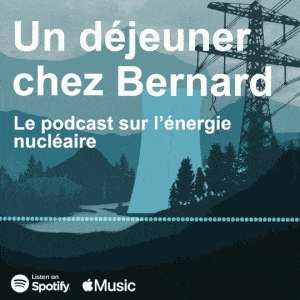Page publiée en ligne le 4 juin 2015
Sur cette page :
• Fabrication Flaws in the Pressure Vessel of the EPR Flamanville-3 (Yves Marignac)
• More contents on Global-Chance.org (Themes et documents)
FABRICATION FLAWS IN THE PRESSURE VESSEL OF THE EPR FLAMANVILLE-3
Yves Marignac, WISE-Paris Briefing, 12 april 2015
Downloads / Summary / Briefing
DOWNLOADS
Fabrication Flaws in the Pressure Vessel of the EPR Flamanville-3 [pdf, 145 Ko]
Yves Marignac, WISE-Paris Briefing, 12 april 2015
French version :
Défauts de fabrication sur la cuve du réacteur EPR de Flamanville-3 [pdf, 145 Ko]
Yves Marignac, WISE-Paris Briefing, lundi 13 avril 2015
(top)
SUMMARY
Fabrication defects detected at the end of 2014 in upper and lower heads of the Flamanville-3 reactor pressure vessel are, by size and characteristics, very serious mechanical defaults. These phenomena strongly put into question the safety case of the EPR (European Pressurized Water Reactor) currently under construction in Normandy.
The reason why a well-known material heterogeneity problem was not solved during the forging of the pieces at Areva’s Le Creusot plant has yet to be investigated. The reason why the defects were detected or publicly released so late, at a moment when the pressure vessel was already in place in the reactor building, also needs to be scrutinised.
Areva will face a very difficult challenge in justifying the safety case for the flawed pressure vessel. The only alternative to demonstrating safety in spite of the defects would be to repair or replace the faulty components, which appears hardly feasible and particularly expensive in the case of the bottom piece. Therefore the future of the entire Flamanville-3 project is at stake.
The problem has also international implications, since at least some of the upper and/or lower heads of the Taishan-1 and -2 EPRs, under construction in China, are apparently also affected. It is also not clear whether components destined for the Hinkley Point-C have been fabricated yet and could be concerned.
Yves Marignac
(top)
BRIEFING
• Safety Significance of the Reactor Pressure Vessel
• Nature of the Defect
• Timing of the Process
• Regulatory Issue
• Alternative Options
• International impact
On the 7th of April 2015, the French Nuclear Safety Authority (ASN) announced that fabrication defects had been found in the reactor pressure vessel (RPV) of the EPR reactor under construction at Flamanville (1). This information was soon confirmed by the manufacturer of the components, Areva, and the operator, EDF (2). Additional information was published by ASN on 8 April 2015 (3). The following is a synthesis of this information completed by direct e-mail and phone communication between ASN and WISE-Paris on 9 and 10 April 2015, and some additional research.
Safety Significance of the Reactor Pressure Vessel
The pressure vessel, which hosts the fission reaction of the nuclear fuel, is one of the most crucial pieces of equipment for the safety of a nuclear reactor. This is even more true in the case of the EPR : with a design capacity of 1,650 MWe, its pressure vessel would hold more nuclear fuel, and therefore a higher potential of danger, than any other reactor in the world. In particular, to exclude any breach of the pressure vessel is key in the safety assessment. Considering the extreme kind of mechanical, hydraulic, thermal and radioactive loads it is exposed to, this imposes very stringent requirements for the mechanical toughness of the pressure vessel. The design pressure is 176 bar and the design temperature is 351°C.
The reactor pressure vessel of the EPR is a cylinder of roughly 12.7 meters high and 5.7 meters diameter (7 meters with the nozzles), made of five main parts : three toruses, of which the upper one holds the nozzles connecting the vessel to the primary loops, and the cap-shaped bottom which are welded together, plus a separate cap-shaped head. Each of these manufactured components as well as the quality of the weldings has to meet specific requirements.
The defects announced on 7 April 2015 concern the pressure vessel head and bottom of the Flamanville-3 EPR. Unlike the largest parts of the pressure vessel that were forged by Japan Steel Works (JSW)—operating the only forge in the world that can process the very large EPR vessel ingots—these smaller parts could be forged by Areva in its plant of Le Creusot.
Nature of the Defect
The vessel closure head is made up of a forged ring, the vessel flange, and a forged partly spherical upper head, penetrated by welded tubes. The lower head is a similar partly spherical forged piece, welded through a forged transition ring to the central core shells. The whole body of the pressure vessel weighs 410 tons, while the vessel head weighs an additional 116 tons.
The pieces are all made of 16MND5 steel. The defect consists in carbon segregation in a certain area of the partly spherical upper and lower heads. It occurs due to insufficient elimination during the forging process of the higher part of the ingot, where carbon tends to concentrate, in the fabricated piece. Why such a well-known phenomenon was not avoided will be, according to ASN, an important part of its examination of the case.
The problem was found recently through destructive tests on a similar vessel head that had been forged in the same conditions. The results are as follows :
• Carbon concentration was found to reach 0.30% in the central area of the forged piece. The fabrication process should ensure, according to the technical specifications applying to 16MND5 steel, that higher concentrations found in the forged piece remain under 0.22%, which is the upper boundary for qualifying materials on the basis of existing studies and return of experience. In other words, as ASN put it, the carbon concentration in the segregated zone brings the material significantly far from the domain of knowledge where the required mechanical properties are well proven.
• This carbon concentration affects the mechanical properties of the material, and most particularly its resilience (its capacity to absorb the energy of a shock, expressed in Joules), which is one of the key properties to be assessed to qualify the pressure vessel. Samples from the segregated zone showed a resilience between 36 J and 64 J, with a mean value of 52 J. This is below the regulatory threshold for the vessel head and bottom, which is of 60 J on average. Taking into account the expected margins, the resilience aimed for and obtained in non-segregated areas is above 100 J.
• The segregated zone is a concentric area with a diameter of around 1.20 meters, on the external face. The depth of the zone remains to be assessed.
Those results are highly likely to be transposable to the head and bottom of the Flamanville-3 pressure vessel, given the very same conditions of their fabrication. Moreover, non-destructive chemical tests on the surface of these parts have confirmed the presence of a similar defect.
Timing of the Process
The ASN was first informed by Areva of the results of the tests in December 2014. These destructive tests were part of the qualification procedure for the components of a pressurized nuclear piece of equipment which the manufacturer has to complete prior to its operation (independently of the whole approval of the reactor start-up, which has to be obtained by the operator).
The head and bottom were apparently forged as early as 2006 (even before EDF obtained the license to create the new reactor at Flamanville, which was granted by a decree in April 2007).
Major defects in the vessel closure head were found by Areva in the Autumn of 2010 and in June 2011. One concerned the welding of adaptor tubes, the other concerned the welding of more than 50 penetrating tubes (out of 107 in total). In October 2011 ASN allowed Areva to carry out deep repair work instead of fabricating a new head. Also some of the tubes probably cross the segregated zone, the reparation process, which is not complete yet, has apparently proceeded without noticing–or taking into account– this problem.
Meanwhile, no such welding issue was raised with the body of the pressure vessel, which was delivered to the Flamanville site in October 2013 and put in place in January 2014. Nevertheless, the destructive testing programme, part of the upper and lower head qualification, was only proposed by Areva to ASN in September 2012. Finally, the tests which revealed the segregated zone were only run in October 2014.
It is unclear for the time being why the industrial process went as far as positioning the pressure vessel in the reactor pit and pursuing the construction around it for many months, when these qualification tests had not even started. This questions both the reason why Areva failed to spot this very important problem at an earlier stage, and the reason why EDF did proceed while qualification was not complete. According to ASN, the reasons for the late testing will be part of the investigation.
Regulatory Issue
Once fully constructed, the EPR reactor in Flamanville-3 would require a final operating license, delivered by ASN under the nuclear regime, to start commercial operation. Prior to that operating license, all pressurized nuclear equipment of the plant, starting with the pressure vessel, must be approved under specific regulations reinforced in 2005. Although previous requirements could have been applied during an exemption period granted in the 2005 ministerial order, ASN made it clear that 2005 regulation fully applies as Areva never asked for such an exemption.
The regulation requires that the manufacturer demonstrates that the pressure vessel meets all the mechanical specifications, of which resilience is an important part. Regarding the parts concerned with the defects, the regulation requires Areva either to prove that the vessel head and bottom meet the mechanical criteria, including an average resilience of 60 J, or to justify that it reaches an equivalent safety level by other means.
Theoretically, there is therefore room for the defective pressure vessel to be qualified through alternative proofing, although the nature and size of the problem will likely make it very difficult, if not impossible. It should also be noted that since vessel head and bottom are not subject to the same operational constraints, the technical assessment could reach different conclusions regarding the acceptability of the two pieces of equipment. In particular, the tube penetrations through the vessel head, needed for the control rods and other instrumentation, introduce further potential weaknesses on welded parts while increasing the mechanical constraints. The lower head, on the contrary, is free of such openings (which is an important change introduced in the design of EPR, compared to previous French reactor designs that had instrumentation penetrations in the bottom plates).
The first step in the reassessment process will be a new series of tests that has already been announced. Areva has proposed a testing programme to ASN, which the authority has yet to approve. This will likely consist of further destructive tests on the similar head, which has already been used. These new tests will specifically aim for a more detailed characterization of the defect. Areva will also need to reinforce the demonstration regarding the transposability of these findings to the actual head and bottom of the Flamanville-3 EPR. Although the programme has yet to be discussed, the French Minister of Ecology already announced that the results are expected by October 2015. The ASN will then consider the justification case which Areva will build upon these results. Whether this could be conclusive, one way or the other, and when ASN could come to a final decision are still open questions.
Another open question is the regulatory status of such a decision and whether and how this could be challenged either by the industrial stakeholders or the project opponents, depending on the outcome. In particular, should a positive decision be granted on the basis of a modified justification, this could fall under the regulatory requirement to start a new license, going through a public inquiry, etc. Also, one important issue will be to clarify who would bear the responsibility either to stop the project or to start the reactor in such a context.
Alternative Options
If Areva fails to provide a convincing alternative proof to complete the safety case, then the only alternative option is to repair or replace the faulty pieces. The fabrication of a new pressure vessel head would be possible. Regarding the lower head, it is technically very unlikely either to separate it from the whole pressure vessel for replacement or to repair it in situ. Any repair or replacement would therefore almost certainly need the entire pressure vessel to be removed, which would be unprecedented and seems very challenging given the progress of work and lack of space inside the reactor building.
The technical hurdles which any repair or replacement solution for the pressure vessel bottom would need to get over, and the major new safety issues related, come with huge costs and high uncertainty. The feasible alternatives, if any, will raise serious issues of profitability. In other words, economic scenario assessments might show that abandoning the project is cheaper than repair or replacement options, when factors such as the financial costs of further significant delays, or the savings on decommissioning costs if the reactor doesn’t go nuclear, are included.
International impact
The question also arises of the potential impact on other EPR projects where similar defects could be found. There is no particular reason to believe that any vessel head and bottom which has been forged by Japan Steel Works would present the same defect. This is the case of those used for the pressure vessel of the Finnish EPR at Olkiluoto, which are therefore not concerned.
On the contrary, upper or lower heads for other EPRs which have been forged at Le Creusot are expected to be as defective. Although it is still not clear, how many and which ones, some of the four parts consisting of the two heads and bottoms of the pressure vessels of Taishan-1 and -2 in China are concerned. One important issue will be the consistency of the technical assessments and the decisions taken by the safety authorities between France and China.
It also remains to be clarified, whether head(s) and bottom(s) have already been forged for the Hinkley Point-C project in Great Britain or even that of Jaïtapur in India, and if so whether they were forged at Le Creusot.
Yves Marignac, 12 april 2015
Notes :
(1) ASN, « Flamanville EPR reactor vessel manufacturing anomalies », press release of 7 April 2015 :
www.french-nuclear-safety.fr/Information/News-releases/Flamanville-EPR-reactor-vessel-manufacturing-anomalies
(2) Areva / EDF, « Flamanville EPR : qualification tests continue on reactor vessel », press release of 7 April 2015 : www.areva.com/EN/news-10490/flamanville-epr-qualification-tests-continue-on-reactor-vessel.html
(3) ASN, « Précisions techniques sur les anomalies de fabrication de la cuve de l’EPR de Flamanville », 8 avril 2015 : www.asn.fr/Media/Files/Precisions-techniques-sur-les-anomalies-de-fabrication-de-la-cuve-de-l-EPR-de-Flamanville
(top)
MORE CONTENTS ON GLOBAL-CHANCE.ORG - themes & documents
Les Dossiers de Global-Chance.org
Climat : n’oublions pas le méthane !
Rapports, analyses, tribunes, interviews, etc. :
Les travaux de Global Chance et de ses membres sur le mésusage du concept de « PRG »
Fukushima : réactions en chaîne
Tribunes, analyses, interviews, etc. :
Les réactions des membres de Global Chance face à la catastrophe nucléaire de Fukushima
Nucléaire : par ici la sortie !
Rapports, analyses, tribunes, interviews, etc. :
Les propositions de Global Chance et de ses membres pour, enfin, sortir du nucléaire
Dossier clos le 31 décembre 2012
Accidents nucléaires : de l’improbable à l’imprévisible
Rapports, analyses, tribunes, interviews, etc. :
Les contributions de Global Chance et de ses membres au débat sur la sûreté nucléaire
Déchets nucléaires : qu’en faire ?
Rapports, analyses, tribunes, interviews, etc. :
Les analyses de Global Chance et de ses membres sur la question des déchets nucléaires
Gaz de schiste : miracle ou mirage ?
Rapports, analyses, tribunes, interviews, etc. :
Les contributions de Global Chance et de ses membres au débat sur les gaz de schiste
Nucléaire : une indépendance énergétique en trompe-l’œil
Rapports, analyses, tribunes, interviews, etc. :
Global Chance et ses membres dénoncent le mythe d’une « énergie 100% nationale »
Nucléaire : quand la facture explose...
Rapports, analyses, tribunes, interviews, etc :
Le débat sur les coûts réels du nucléaire vu par Global Chance et ses membres
Bure : ceci n’est pas un débat public
Contributions, analyses, vidéos....
Global Chance et ses membres dans le « débat public » sur le projet Cigéo
(top)
Publications de Global Chance
Imaginer l’inimaginable ou cultiver son jardin ?
Les Cahiers de Global Chance, n°37, juin 2015, 100 pages
Autour de la transition énergétique : questions et débats d’actualité (suite)
Les Cahiers de Global Chance, n°36, novembre 2014, 68 pages
Autour de la transition énergétique : questions et débats d’actualité
Les Cahiers de Global Chance, n°35, juin 2014, 84 pages
Le casse-tête des matières et déchets nucléaires
Les Cahiers de Global Chance, n°34, novembre 2013, 76 pages
Des questions qui fâchent : contribution au débat national sur la transition énergétique
Les Cahiers de Global Chance, n°33, mars 2013, 116 pages
L’efficacité énergétique à travers le monde : sur le chemin de la transition
Les Cahiers de Global Chance, n°32, octobre 2012, 180 pages
L’énergie et les présidentielles : décrypter rapports et scénarios
Les Cahiers de Global Chance, n°31, mars 2012, 100 pages
...
Nuclear power, the great illusion. Promises, setbacks and threats
Les Cahiers de Global Chance, n°25 bis, october 2008, final version
(top)
Publications de membres de Global Chance (selection)
Audition de Yves Marignac par la commission d’enquête de l’Assemblée nationale sur les coûts de la filière nucléaire
Yves Marignac, mercredi 26 mars 2014 / Document support : Diaporama « L’échéance des 40 ans pour le parc nucléaire français », 16 pages
L’échéance des 40 ans pour le parc nucléaire français
Processus de décision, options de renforcement et coûts associés à une éventuelle prolongation d’exploitation au delà de 40 ans des réacteurs d’EDF
Yves Marignac, Wise Paris, samedi 22 février 2014, 171 pages
Discours d’acceptation du « Nuclear-Free Future Award 2012 »
Yves Marignac, Heiden (Suisse), samedi 29 septembre 2012
Sûreté nucléaire en France post-Fukushima. Analyse critique des évaluations complémentaires de sûreté (ECS) menées sur les installations nucléaires françaises après Fukushima
Arjun Makhijani et Yves Marignac, Rapport d’expertise IEER / WISE-Paris, 176 pages, lundi 20 février 2012
Manifeste négaWatt : réussir la transition énergétique
Thierry Salomon, Marc Jedliczka et Yves Marignac, Association négaWatt / Éditions Actes Sud, janvier 2012, 376 pages
(top)
 Global Chance
Une expertise indépendante sur la transition énergétique depuis 1992
Global Chance
Une expertise indépendante sur la transition énergétique depuis 1992





